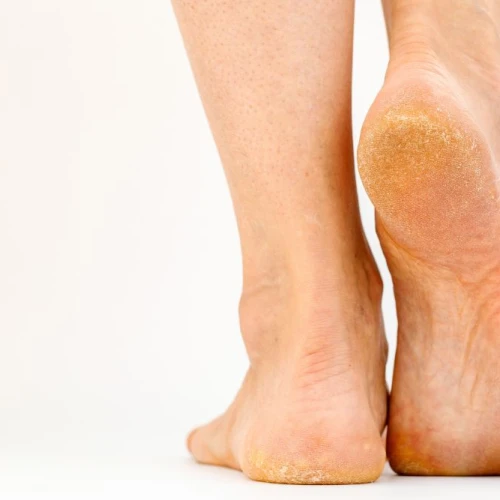What are the symptoms?1
It's easy to tell whether your feet are dry or not. The skin will be rough and hard, especially in the weight-bearing areas (heel and forefoot). The appearance of the skin in these areas will resemble “dried earth” and have a yellowish colour. Severely dry soles of the foot can also cause heel cracking, causing pain when walking. In the most serious cases, untreated skin dryness can cause cracking. Cracks are deep grooves in the skin.
What causes dry feet?1
Like the skin on the hands, the skin on the feet is exposed to a number of external factors including cold weather in winter, hot weather in summer, repeated rubbing with shoes and/or socks, moisture, etc. Feet are also an area that is often overlooked when moisturising the skin after a shower. A lot of people forget to moisturise the skin on their feet! All these factors contribute to having dry skin on the feet.
Dry feet: what are the risks?1, 2, 3
Having dry feet favours the development of hyperkeratosis, which is the abnormal thickening of the corneal layer of the epidermis (the top layer of the skin). Hyperkeratosis causes corns and calluses on the feet, as well as other types of keratoses named according to their location:
- A corn, which is a small area of hardened skin on the feet which often develops on the tops of the toes (especially the last three), on the joints between the toe phalanges, or on the outside of the little toe.
- A partridge eye, which is a thickening of the skin between two toes.
- A callus, which is the thickening of the skin under the forefoot.
In addition to hardened skin, untreated dry heels can develop cracks, accompanied by peeling, bleeding and lesions that become infected in the worst cases (bacterial infections, athlete's foot, etc.).
How to treat dry feet naturally1
If you have dry feet, we recommend applying a special cream for hard skin and calluses every day. This type of cream moisturises the dead cells on the surface of the skin, helping to reduce the thickness of the corneal layer on the heels and under the arch of the foot. Massage the cream from your toes to the heel.
If you have a number of corns on your feet, use a pumice stone or an electric hard-skin remover once or twice a week. Note: these instruments should be used with care as removing too much skin from the calluses on your feet stimulates the skin production. It’s a vicious circle. If you are unsure about how to treat dry feet, make an appointment with a pedicurist/podiatrist.
How to stop getting dry feet1
Here are a few practical tips to stop you getting dry feet:
- Take a shower rather than a bath. If you do like taking a bath, don’t take more than two or three a week. Don’t stay for too long in the bath; take a warm bath rather than a hot one, and don’t use foaming products.
- Don’t use “harsh” soaps such as vegetable-oil soaps, as they dry out the skin. It’s best to use soaps intended for dry feet (extra oily soaps or soap-free soaps) or a moisturising gel.
- In the evening before going to bed, bathe your feet for 5 minutes, rub the skin with a specially designed glove to remove softened dead skin, dry the skin thoroughly (not forgetting the spaces between the toes) and put on cotton socks to wear all night. Perform this routine once or twice a week.
- Massage your feet with a moisturising cream every day.


